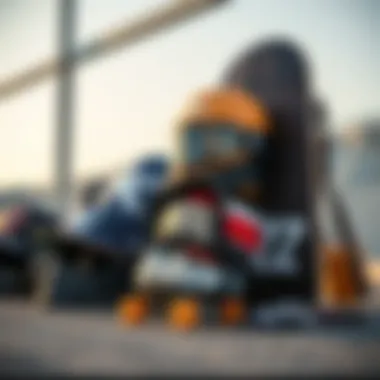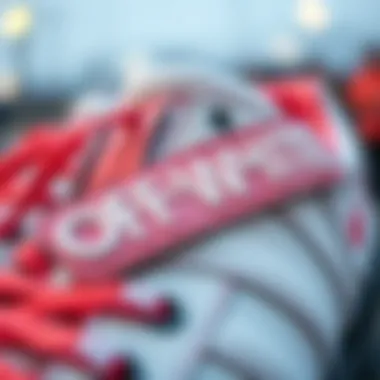Skate Authentic Off-White: Culture and Style Insights


Intro
Skateboarding has long been more than just a sport; it’s a lifestyle, a culture, and for many, an identity. As the world shifts and trends rise and fade away, certain brands manage to capture the essence of the skateboarding community. Off-White, known primarily for achieving a chic blend of high fashion and urban aesthetics, offers a unique lens through which the relationship between skate culture and style can be explored.
In this piece, we aim to delve into this intricate dance between authenticity and branding. Authenticity in skate gear isn’t merely about functionality; it's also about representing true values within the community. For skateboarders, it’s essential that what they wear reflects their personal journey, not just a logo or trendy design. Off-White emerges as a significant player here, entwining luxury with street cred. By dissecting how this brand shapes the perception and ethos of skate culture, we can appreciate the evolution of personal styles that remain grounded in genuine experiences.
We'll analyze essential skateboarding techniques, gear and equipment, and explore how the aesthetics of Off-White fit into this world. Each section is here to provide insight into making informed choices, all while staying true to oneself. Whether you are a curious outsider, seasoned skateboarder, or someone in the industry's thick fog, this article will shed light on the values that bind us all.
As we navigate through these topics, remember that choosing the right gear isn’t only about looking good; it’s part of a larger conversation about community and authenticity. So, let’s get rolling into the heart of skateboarding culture and style.
Understanding Skateboarding Culture
Skateboarding culture is a vibrant tapestry of creativity, rebellion, and community. It goes far beyond the act of riding a board; it embodies a way of life that values freedom and self-expression. Therefore, any exploration of skateboarding, especially in relation to something as influential as Off-White, must begin with a profound understanding of its culture. To appreciate the significance of skate gear and its authenticity, one must grasp the nuances that define this unique subculture.
The Roots of Skateboarding
Skateboarding’s history takes us back to the late 1940s and early 1950s in California. Initially, surfers sought ways to replicate the waves on land, leading to the development of what we now recognize as skateboard riding. Through the years, skateboarding evolved from crude wooden planks with roller skate wheels to a global phenomenon. Not just a sport, it became a symbol of youth defiance and innovation.
As the culture emerged, it intertwined with various arts—primarily music, graffiti, and fashion. These influences created a unique environment where creativity thrived. By the 1970s and 1980s, skateboarding broke into mainstream consciousness, yielding the birth of iconic skate parks and the introduction of legendary skaters like Tony Hawk.
Understanding these roots is essential as it provides context for how skateboarding, and by extension brands like Off-White, developed their identities and continue to influence global trends.
Core Values in Skate Community
At its heart, the skate community thrives on principles that go beyond just tricks and stunts. Inclusivity, creativity, and a deep-seated passion for the sport are cornerstones of this culture. Skaters often pride themselves on their individuality; each deck painting or trick performed tells a part of their story.
- Inclusivity: Unlike many sports, skateboarding often welcomes participants regardless of skill level or background. Local skate spots can transform into melting pots of diversity.
- Creativity: Skateboarding is an art form in itself, where personal expression is depicted through styles and gimmicks.
- Passion: For many skaters, this is about more than just a pastime; it’s a lifelong devotion.
These values also influence how skaters perceive gear. Authenticity in skate products isn’t just a trend but a vital aspect of their identity. The gear they choose has to resonate with their beliefs and experiences, making it pivotal to discuss how authenticity plays into the larger narrative of skate culture.
The Evolution of Skateboarding Style
The evolution of skateboarding style is a remarkable reflection of cultural shifts and technological advancements. In the 1980s, clear influences from punk rock and hip-hop began to materialize. The choice of clothing, from baggy pants to colorful graphic tees, became markers of identity.
As skateboarding grew, so did the footwear and apparel associated with it. Brands like Vans and Converse became more than just shoes; they were pieces of skate culture history.
Moving into the 2000s and beyond, the fusion of skate culture with high fashion opened up new avenues. Designers like Virgil Abloh of Off-White commenced a dialogue between streetwear and high end, allowing skate culture to gain a foothold in the luxury market. It is a transformation that has led to a unique blend of function and style, and understanding this evolution is crucial for those looking to navigate the contemporary skate scene.
"In the world of skateboarding, every trick is a narrative, and every board tells a story."
By appreciating the culture's deep roots, core values, and its evolving style, readers can better understand the significance of skateboarding in today’s society. This lays a strong foundation for discussing authenticity, gear, and brands like Off-White within the context of this rich history.
The Significance of Authenticity
Authenticity in skateboarding is more than just a buzzword; it’s the bedrock of the culture itself. It embodies a fierce sense of individuality and a deep-rooted bond among enthusiasts, fostering trust and respect within the skate community. When individuals seek authentic skate gear, they are not merely buying equipment; they are investing in a lifestyle that champions originality and expression. Skateboarding demands gear that not only performs well but also resonates with the identity of the rider.
Authenticity ensures that the art of skateboarding remains rooted in its core values, promoting self-expression while maintaining the integrity of its origins. This section seeks to delve deeper into the essence of authenticity, examining how it shapes perceptions within the community and the market.
Defining Authenticity in Skate Gear
When talking about authenticity in skate gear, we can point to several key characteristics. First, the materials and craftsmanship play a major role; gear made from high-quality materials demonstrates a commitment to durability and performance, which is crucial for skaters pushing their limits. For instance, companies like Baker Skateboards or Element are known for their genuine commitment to quality.
Second, authenticity encapsulates the brand's culture. When a brand honors its skateboard origins, embraces its history, and speaks to the community, the connection strengthens. That’s why many skaters gravitate towards brands with a genuine history in skateboarding, making choices that reflect their values.
If a brand is just jumping on the latest trends without any substantial ties to skate culture, it often falls flat. In fact, discerning skaters can spot a plastic imitation from a mile away.


Authentic Vs. Trendy: A Critical Perspective
In today’s market, the line between authenticity and trendy fashion often blurs. On one hand, there are brands that produce stylish pieces meant to appeal to the masses—clothing that’s fashionable yet lacks the narrative that binds it to the skate culture. These trendy bits may look good but might fail to offer the performance needed for serious skating.
A critical perspective encourages skaters to think carefully about what drives their purchases. Popular brands and collaborations might flood social media, creating a sensation around certain products, but the underlying question remains: does this gear truly resonate with my skating experience?
There’s also the danger of over-saturation; if an item becomes ubiquitous, it risks losing its original allure. A skater wearing a sought-after piece might find it signifies conformity rather than individuality. Thus, the authentic skater must discern what remains true to themselves amidst the noise of the trendy offerings.
Impact of Authenticity on Skater Identity
Identity in skate culture is largely shaped by one's choices—choices in board designs, apparel, and even language. Authentic gear not only provides the right tools for skating but also communicates identity to the outside world, reinforcing a sense of belonging to a tribe.
Wearing gear that represents genuine craftsmanship and culture can evoke a feeling of pride. For instance, when someone spots a classic Santa Cruz t-shirt, it instantly recalls an era rich with history in the skate scene. It says, "I know where I come from."
Moreover, authenticity influences how skaters are perceived by their peers. A commitment to authenticity often earns respect within the community. Skaters can often tell who’s in it for the thrill versus those who simply want to look good posting on Instagram. This unspoken judgment shapes dynamics, leading to a deeper camaraderie based on mutual understanding of what true skating represents.
"Authenticity is not just a label; it’s the heartbeat of our culture that keeps us connected."
In essence, as skaters navigate through trends and styles, understanding the significance of authenticity equips them with the insight needed to select gear that aligns with who they are and what skateboarding truly means. This sense of identity, stemming from authentic choices, continues to fortify the foundational spirit of skateboarding.
Off-White: A Fashion Powerhouse
When you mention Off-White, a wave of recognition washes over the fashion landscape. This brand is not merely an addition to the ever-growing realm of streetwear; it has carved its niche, influencing trends across diverse communities, including skateboarding. Off-White's role in the skate scene isn't just about slapping a logo on a t-shirt or sneakers. It embodies a transformation in how skateboarding culture interacts with fashion and personal expression.
The fusion of high-end fashion and skate culture has historical roots, but Off-White has elevated this relationship to new heights. By infusing elements of conceptual art and contemporary fashion into skate gear, Off-White pushes boundaries, compelling skaters and enthusiasts alike to view their style choices as more than just functional but as a form of identity and artistry. This brand attracts not just skaters but also those who appreciate a more daring and experimental approach to fashion.
The Founding of Off-White
Off-White was birthed in 2012 by Virgil Abloh, a name synonymous with innovation in the realms of streetwear and luxury fashion. The label was established on the simple premise of challenging conventional design norms. Abloh, with his keen sense of culture and style, managed to merge street culture, fashion, and contemporary art into a single entity. His unique vision was further amplified when he became the artistic director of Louis Vuitton's menswear, placing Off-White at the forefront of a fashion revolution.
Off-White quickly gained traction, offering fresh takes on traditional pieces, often utilizing ironic quotes and striking graphics. This approach resonated with a broad audience. It was not just clothing; it was a statement.
Virgil Abloh's Influence on Streetwear
Virgil Abloh changed the game in many dimensions. His philosophy revolved around the accessibility of luxury, effectively democratizing high fashion. With his background in both architecture and fashion, he brought an architectural perspective to garment creation, focusing on how pieces interact within pop culture.
In the skateboarding scene, Abloh's influence cannot be understated. He collaborated with established figures and brands, melding their aesthetics with his innovative design. He encouraged skaters to fuse functionality and flair, showcasing that skate fashion can be as much about the art as it is about the wearability.
The Intersection of Skateboarding and Off-White
The intricate relationship between skateboarding culture and Off-White illustrates the synthesis of style and functionality in modern skate wear. As skateboarding evolves beyond a mere pastime into a recognized art form, the intersection with high-fashion brands like Off-White draws attention, not just for aesthetic appeal but also for what it signifies for the skating community as a whole. This section explores how Off-White's unique approach appeals to skateboarders, the collaborative efforts with established skate brands, and the community's nuanced reactions to these developments.
How Off-White Appeals to Skate Culture
Off-White’s allure within skate culture can largely be attributed to its street cred and daring designs that resonate with skaters' desire for individuality. The brand breaks away from traditional skate gear, offering items that are both visually striking and functional. By incorporating quintessential skate aesthetics—like baggy fits and bold graphics—Off-White demonstrates an understanding of what skaters want while pushing the boundaries of the norm.
Moreover, Off-White’s branding often reflects the innate rebellious spirit of skateboarding. Their use of ironic slogans and deconstructed styles resonates with many skaters, who appreciate the blend of high fashion and their subculture. This speaks volumes: skaters want to see themselves represented in the brands they wear, and Off-White does that exceptionally well without alienating the core values of skateboarding.
Collaborations with Skate Brands
Collaboration is a concept deeply rooted in skate culture, where brands often partner with skaters to create unique gear that speaks to the community. Off-White has leveraged this ethos by collaborating with several skate brands, showcasing not only respect for skate history but also an understanding of ongoing trends. For instance, their partnership with Nike led to the creation of sneakers that combine performance with high-fashion flair, appealing to both skaters and sneakerheads alike.
These collaborations serve a dual purpose; they elevate skate fashion and provide authentic, quality products that skaters can rely on while performing tricks. The merging of Off-White’s style with fundamental skate gear reflects a comprehensive vision of what skate culture can become while still holding true to its roots.
- Examples of notable collaborations include:
- Off-White x Nike SB Dunk High
- Off-White x Pyrex Vision


Such partnerships have sparked discussions on authenticity, bridging the gap between street wear and luxurious fashion. For many skaters, wearing gear from these collaborations signifies a complex identity that marries style with a lifestyle rooted in passion, creativity, and authenticity.
Community Reactions to Off-White's Skating Gear
The response from the skating community regarding Off-White's foray into this arena has been mixed. On one hand, many appreciate the infusion of creativity and the inclusive designs that accompany Off-White's skating gear. There's a sense of recognition that the gear not only matches skaters’ performance needs but also empowers their identity in a visibly unique way.
On the other hand, skepticism persists among some purists who argue that Off-White's association with skateboarding could dilute what skate culture stands for. Concerns arise over the commercialization of a subculture that has traditionally thrived on authenticity, individuality, and resistance against mainstream norms. In this regard, Off-White's price points also come under fire, with critiques surrounding accessibility for budding skaters who may not share the financial means to invest in high-end gear.
"Skateboarding should be about freedom and creativity, not about wearing brands that cost an arm and a leg – it’s about the love of skating itself!"
Overall, the community's response highlights a broader discussion about authenticity and the balance of style and functionality, showing that as skate culture continues to evolve, so do its interpretations of value and identity. As these conversations unfold, both Off-White and the skate community navigate a constantly shifting landscape where the lines between culture and commerce blur.
Navigating the Market for Authentic Skate Gear
Skateboarding gear isn’t merely about function; it's a reflection of identity within the skate community. In recent years, the market has become flooded with knock-offs and trendy items that can easily confuse even the most ardent skate fans. Consequently, understanding how to navigate this landscape for authentic skate gear is essential. It's not just about purchasing a skateboard or some shoes; it's about aligning with the culture and values that come with being a skater. In this section, we will delve deep into recognizing genuine products, avoiding common pitfalls in the marketplace, and sourcing Off-White skateboarding products that genuinely resonate with the ethos of skate culture.
Identifying Authentic Products
When it comes to authentic skate gear, knowing what to look for can make all the difference. Genuine skate products are typically designed with durability, comfort, and performance in mind. Here are several key indicators that can help you identify authentic gear:
- Brand Labeling: Always examine the branding on the items. Legitimate brands, including Off-White, ensure that their logos are consistently placed and styled. If something seems off, it might be an imitation.
- Material Quality: Genuine skate products often use high-quality materials. Touching and testing the item can show if it feels durable and robust.
- Stitching and Craftsmanship: Look closely at stitching. Authentic brands take pride in their craftsmanship, and you should expect clean, consistent stitching without loose threads.
"The right gear empowers skaters, transforming each trick into a statement of authenticity and skill."
Buying authentic items assures you not just quality, but a certain level of respect and acknowledgment within the community. You want to ride with gear that supports your skills and sends a message about your skateboarding journey.
Common Pitfalls in the Skate Gear Market
Skateboarding enthusiasts often face certain challenges when venturing into the gear market. Recognizing these common pitfalls will help you make informed decisions:
- Overpaying for Trends: Many brands push items as exclusive or rare when, in fact, they have little value. It’s crucial to research and verify before spending your dough.
- Ignoring Product Reviews: Don't go in blind. Checking what fellow skaters say about specific gear can save you from a poor purchase that doesn't hold up on the board.
- Falling for Counterfeit Products: It’s all-too-easy to stumble onto a counterfeit product, especially when deals seem too good to be true. Always purchase from reputable retailers or the brand's official website.
Where to Buy Authentic Off-White Skating Products
Finding authentic Off-White skating gear requires some savvy. Here are a few trusted sources:
- Official Retailers: Websites like Off-White's official site or verified partners often carry the latest and most authentic offerings.
- Skate Shops: Local skate shops can be a goldmine for authentic gear while supporting the community.
- Specialized Online Marketplaces: Platforms such as StockX or Grailed provide a trustworthy venue for purchasing exclusive items, provided they verify the authenticity of products before listing them.
While navigating the waters of skate gear might seem daunting at times, being informed will enable you to acquire authentic pieces that genuinely represent your style and commitment to skateboarding culture. In the end, each choice you make contributes to who you are as a skater.
Fashion Meets Functionality
Skateboarding is as much about the culture as it is about the gear. In a sport that thrives on innovation, the connection between fashion and functionality is paramount. This section delves deep into how the aesthetic appeal of skate gear complements its practical performance on the board. For skaters, looking good is important, but no one wants to sacrifice their safety and comfort in pursuit of style. Hence, achieving a harmonious balance between these two facets is not just beneficial, it’s essential.
Balancing Style and Performance in Skate Gear
Finding that sweet spot—where style meets performance—is the holy grail for many skaters. Styles evolve; what appealed to a young skater five years ago might not cut it today. However, performance remains constant. Skating involves skill and resilience; the right gear can make or break your flow. For instance, slim-fit jeans might be trendy, but if they restrict movement, they're of no use in executing a trick.
Wearing branded footwear like Nike SB or Adidas Skateboarding could elevate your look while ensuring grip and support. These shoes are engineered not merely for aesthetics but also for performance, so they protect the feet during grinded tricks or jumps. But the key lies in how each skater defines their blend of style and utility, often a reflection of their skating style and personal tastes.
Durability in Skateboarding Apparel
Durability stands as a cornerstone in skateboarding apparel. It’s not just about looking good; gear must withstand the daily grind of kicks, scratches, and harsh landings. Skateboarding gear ought to grapple with abrasiveness, moisture, and maybe even the unpredictable elements of nature. For instance, a hoodie from Supreme might ignite envy, but its material must endure a fall just as well as a skater’s skin.
Many brands prioritize materials like canvas and denim, known for their resilience. Reinforced stitching and durable fabrics help ensure longevity, which is indispensable for skaters trying to stretch their budget over multiple months. Whether you’re rocking a pair of Volcom cargo shorts or a classic pair of Dickies work pants, look for gear that can take a beating and come back strong.
Choosing Gear Based on Skating Style


Every skater has a unique style—be it street, vert, or downhill—and gear should align with that style. Street skaters often prefer loose clothing for mobility, while those who gravitate toward vertical ramps might choose tighter fits to avoid any gear getting caught mid-air. This choice also extends to skateboard shape and materials, where some may go for wooden boards for a traditional feel, while others might opt for plastic to bring a splash of color and fun.
Furthermore, it’s wise to consider personal comfort and preference. Some might find skate shoes with extra padding necessary for comfort, while others may value a feather-light feel for agility. Choosing the right gear based on one’s skating style ultimately enriches the experience, leading to greater confidence and better tricks. A skater’s wardrobe evolves, but the understanding of what to wear for different styles can separate the amateurs from the seasoned veterans.
"Your gear tells your story. Wear it with pride, but make sure you can work it."
This perfect blend of fashion and function should not only define a skater’s look but also reinforce their identity within the ever-evolving landscape of skate culture. As skateboarding continues to bridge the gap between sport and streetwear, never underestimate the power of a well-chosen outfit when rolling on the streets.
Analyzing Skater Influences
In the multifaceted world of skateboarding, the interplay of various influences has created a dynamic cultural landscape. Understanding these influences, from prominent figures to the digital realm, sheds light on how street style evolves and finds its expression among skaters. The significance of analyzing skater influences lies not only in recognizing key players in the scene but also in understanding the channels through which these influences are disseminated. This exploration provides insight into how trends are set or challenged within the community.
Influential Skate Figures and Their Impact
From Tony Hawk carving out his legacy to Nyjah Huston dominating competitions, influential skaters have shaped the identity of skateboarding. They are more than mere athletes; they represent the embodiment of passion, grit, and creativity.
- Legacy of Pioneers: Figures like Stacy Peralta and Steve Caballero laid the groundwork for modern skate culture, paving ways for newer generations to innovate and adapt. Their footwear collaborations and fashion choices have become iconic.
- Impact on Youth: Young skaters often idolize these figures, adopting their fashion sense and skating style. This creates a ripple effect where the youth incorporate elements of their idols into their personal style.
- Cultural Critique: Not only do skaters influence style, but they also often engage in social issues, reflecting the ethics and values of skate culture. These aspects give depth to their influence, proving that style in skateboarding is not merely about appearance but also a form of expression.
Social Media's Role in Skater Fashion Trends
In today's digital age, social media is a critical player in the dissemination of skate fashion trends. Platforms like Instagram and TikTok have become virtual runways for many skaters, showcasing not just their skating skills but also their fashion choices.
- Visual Impact: Short videos and photographs allow skaters to highlight unique combinations of gear, demonstrating versatility. This visibility encourages others to mimic these styles.
- Engagement and Feedback: Engagement on social platforms facilitates a two-way conversation between skaters and their followers, blurring the lines between influencer and audience. This connection serves as real-time feedback and inspiration, driving trends even further.
- Global Influence: A skater in one corner of the world can inspire individuals thousands of miles away. The internet enables a global exchange of ideas and styles, enriching skate culture and making it more diverse.
The Rise of Influencer Partnerships
Recent years have seen a notable rise in partnerships between established brands and skater influencers. These collaborations often merge skate culture with mainstream fashion, creating unique offerings that resonate with both communities.
- Brand Visibility: For brands like Off-White, collaborating with well-known skaters not only enhances visibility but also lends authenticity. Such partnerships often come across as credible because they are rooted in a genuine appreciation for skate culture.
- Adapting Trends: Skaters often have a finger on the pulse of what’s popular and what isn’t. Brands tapping into this knowledge can produce lines that align closely with current trends, ensuring they meet market demands.
- Shaping Identity: These collaborations allow skaters to express their identity while broadening the brand's appeal, thus creating a symbiotic relationship that benefits both parties. Skater identities become intertwined with brands, further complicating the idea of authenticity in fashion.
Analyzing skater influences is far more than just a study of trends; it is an exploration of how cultural exchanges define a community. It highlights the connection between skateboarding and broader societal themes, making it essential for both enthusiasts and industry professionals to engage with these evolving narratives.
The Future of Skate Style
As we look toward the horizon of skate fashion, it becomes clear that the evolution of skate style is intertwined with broader societal changes. The landscape of skateboarding is not static; it continually adapts to reflect the values and preferences of new generations. Importantly, the future of skate style is shaped by emerging trends, the growing consciousness around sustainability, and the influence of major brands like Off-White.
Emerging Trends in Skatewear
Skatewear is beginning to view itself through a more dynamic lens, recognizing that clothing is not just about utility, but about self-expression. Some key emerging trends include:
- Layering Techniques: Skaters are gravitating towards layering, mixing materials and styles. This not only enhances functionality but also opens avenues for personal style. A baggy T-shirt over a tight-fit long sleeve, topped with an oversized jacket provides options for changing weather while still looking fresh.
- Gender Fluidity: The lines in skateboarding apparel are blurring regarding gender. Brands are taking notice, producing unisex styles that cater to all skaters. This inclusivity resonates deeply with the community, emphasizing individuality over conformity.
- Tech Fabrics: With advancements in textile technology, breathable and moisture-wicking materials are making their mark. This means skaters can pull off high-performance gear that also looks good. The days of sacrificing comfort for style may be fading.
These trends reflect a culture moving forward, simultaneously keeping its roots in mind. As skaters continue to embrace personal expression, the fabric of skate style will respond accordingly.
Sustainability and Ethical Brands
In recent years, there has been a palpable shift towards sustainability within the skate community. Skaters are becoming more aware of the environmental impact that clothing production has. This consciousness is prompting discussions on sustainability and ethical practices in skatewear. Some notable shifts include:
- Recycled Materials: Brands like Patagonia and Etnies are leading the charge on utilizing recycled materials, creating an eco-friendly ethos in skatewear. These brands are well-regarded, representing the voice of a generation.
- Transparent Supply Chains: Skaters are increasingly supportive of brands that are open about their manufacturing processes. Knowing that a product is produced ethically adds an extra layer of authenticity that is paramount in skate culture.
- Local Artisan Collaborations: Supporting local craftsmen and small businesses not only promotes community but also reduces the carbon footprint associated with global shipping.
Incorporating sustainable practices isn't just a trend; it's becoming part of the identity of modern skate culture. Brands are responding as skaters call for action, and this alignment of values is reshaping how we think about style.
The Ongoing Influence of Off-White
Off-White's impact on skate culture has been profound, navigating the balance between streetwear and traditional skate fashion. Virgil Abloh's vision has supplemented skate style with a high-fashion twist. Key points regarding Off-White’s influence include:
- Cross-Genre Collaborations: Off-White has collaborated with several skate brands, creating a blend of aesthetics that elevates both high fashion and street apparel into the sphere of exclusivity and desirability. This cross-pollination of styles is pushing boundaries within skatewear.
- Visual Identity and Logos: The distinctive use of quotation marks and industrial patterns has now become symbols of status among skaters. Skaters are not just looking for functionality; they also want their gear to communicate something about their identity.
- Social Media and Brand Visibility: As skaters showcase their Off-White gear online, there is a ripple effect. More skaters begin to incorporate these styles into their routines, thus influencing what is seen as popular within the community.
In summary, Off-White continues to push the envelope in skate fashion, proving that the intersection of style and skate culture can yield groundbreaking results. As the future unfolds, the continual influence of Off-White and similar brands will be pivotal in defining skatewear for years to come.
"Fashion is a way to express yourself. If you’re not willing to be authentic, you might as well not bother at all." - A thought resonating deeply in the skating community.
Navigating through emerging trends, sustainability efforts, and brand influences reveals a shifting terrain in skate style. The future looks promising, as individuality reigns supreme in every shred, kickflip, and ollie.







